Commercial Solar Panel System Inverters vs Optimisers
Choosing The Right inverter for your commercial solar panel system
When installing a commercial solar panel system, choosing the right type of solar panel inverter is a crucial part of your investment. Solar inverters convert the direct current (DC) produced by your solar PV panels into alternating current (AC), which is the usable form of electricity needed for most appliances and systems.
As a core component, the inverter ensures that your solar setup powers your business or home efficiently. Here, we explain the advantages and disadvantages of each setup in complete detail.
There are three main types of solar inverters for Commercial solar panel system installations:
✅ Micro-Inverters
✅ Power Optimisers
✅ String Inverters
Each one generates and converts energy from your photovoltaic (PV) solar panels into electricity your business can use, but how they achieve this is certainly different mechanics.
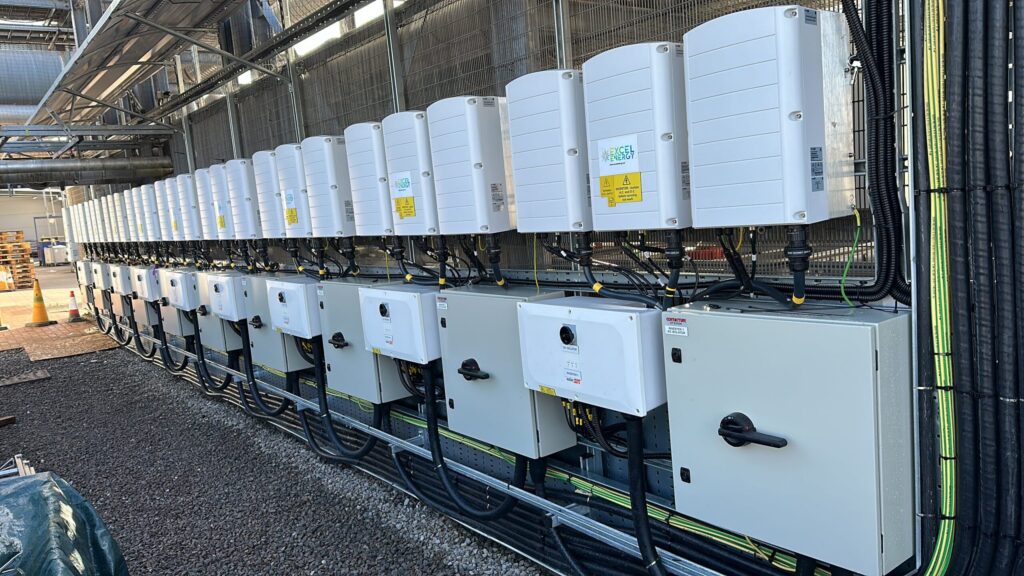
Where do String Inverters fit in a commercial solar panel system
A String inverter is installed on your business premises, typically close to the main Incomer by the distribution Boards.
The electricity is generated by the solar panels typically in a twenty-panel set-up making one string connected in a series circuit, then energy generated is sent to the inverter via a PV1-f dc cable, PV H1Z2Z2-K, where it is converted to Alternating Currents (AC) current and sent to your business apparatus ready for use.
In a commercial solar panel system, the panels are typically connected in a series circuit. This means that if one panel in the string encounters an issue, such as shading, the energy production of the entire string will be reduced to the level of the affected panel.
For instance, if one panel in a string is shaded and can only generate 100 watts, all other panels in that string will also be limited to 100 watts of energy production. This is a key consideration in the design and installation of your commercial solar panel system, as shading can significantly reduce the overall energy output.
A commercial solar panel system installation with a 50kW inverter typically has five Maximum Power Point Trackers (MPPTs), allowing for 10 strings per inverter.
This setup is commonly used for simple, unshaded roofs in businesses that generate energy using solar PV systems.
Pros and cons of Solar sytem string inverters
Every commercial solar panel system requires an Inverter to operate. Our design teams at Excel Energy will design the most efficient one for your business. Let’s look at some of the advantages and disadvantages of each inverter type.
String inverter pros and cons.
Pros
✅ Easy to troubleshoot
✅ Low cost
✅ Simple system design
Cons
❌ Efficiency in shade or single-panel issues
❌ Difficult system expansion
❌ 10-year lifespan
❌ Additional equipment needed for rapid-shutdown requirements
❌ Lacks details on the online monitoring portal
❌ Inverter issue impacts the entire system
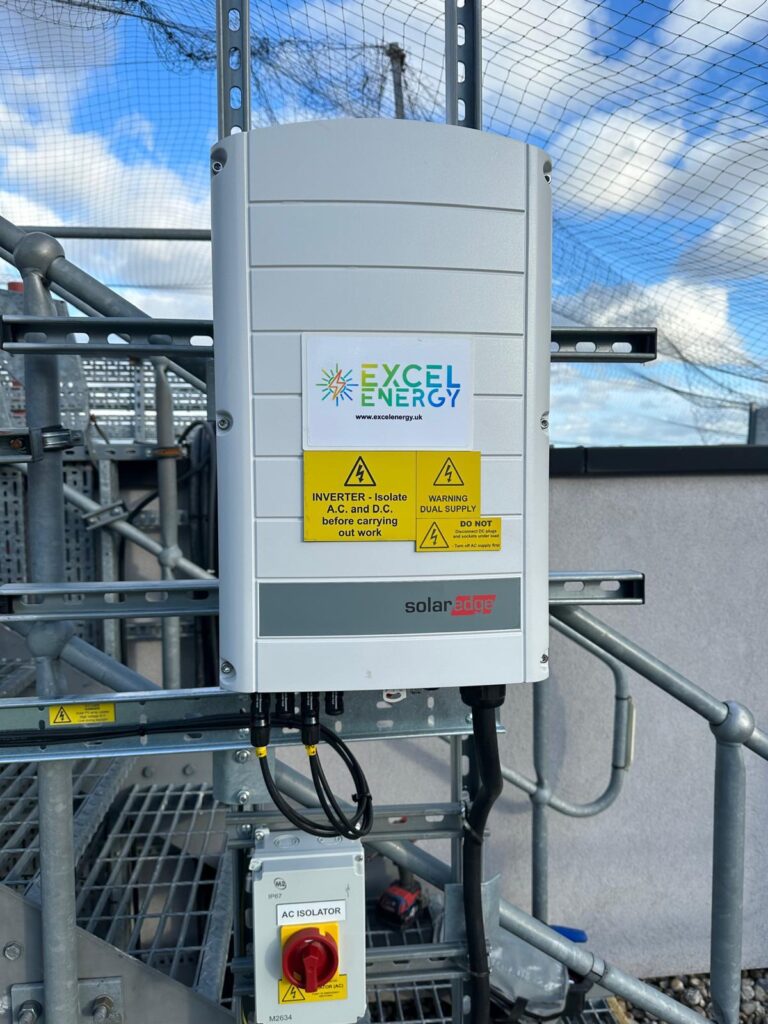
One of the biggest benefits of String inverters is their simplicity. Often, if there is an issue with a solar panel system, it has to do with the inverter. With String inverters, there’s only one, so troubleshooting and repairing the issue is simple, and no one has to get on your roof to repair it unless there is a string issue.
String inverters are more affordable compared to other inverter options, but they are less effective in situations where shading is an issue. Additionally, they require rapid shutdown devices to be integrated with your fire alarm system to address potential DC arc faults, which can add to the overall installation cost.
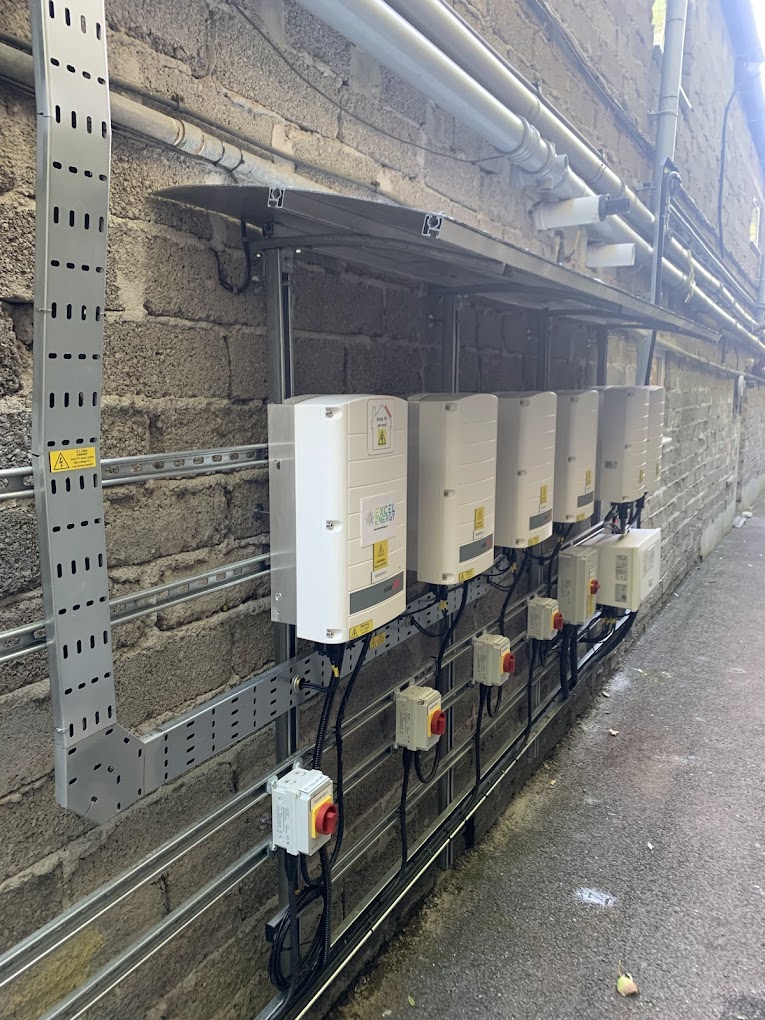
The drawback with string inverters
The drawback of string inverters is that if one panel encounters an issue, it can affect the energy production of the other panels connected to the same string.
This can reduce the overall electricity available for your business and decrease your solar savings. If not properly considered during the design stage, the system may become less efficient than it could be.
Power optimisers can help mitigate the impact of shading or panel issues, but adding this extra equipment increases the overall cost. Additionally, if the String inverter malfunctions, the entire system will be offline until the inverter is repaired, which can lead to downtime and reduced energy production.
Due to the way commercial solar panel systems are wired together and the voltage requirements of String inverters, they are not ideal for complex system designs with panels on multiple roof angles or orientations.
They also cannot easily accommodate the addition of more panels in the future without installing a new system. Additionally, String inverters have a shorter lifespan of around 10 years, whereas solar panels typically last 25 to 35 years, meaning you will likely need to replace the String inverter at least once or twice during the system’s lifetime.
Power Optimiser inverter set up
Power-optimised inverters are used with DC power optimisers, typically installed beneath each solar PV panel and physically mapped by the installation team for site monitoring.
These optimisers track each panel’s peak output and regulate the power generation and DC voltage before sending it to the inverter, where the energy is converted from DC to AC. This setup maximises efficiency by ensuring each panel operates optimally, regardless of shading or other issues affecting individual panels.
Power optimisers play a key role in managing the energy generated by a commercial solar panel system. By controlling the output of each panel, they ensure that the combination of solar panels and power optimisers allows each unit to achieve its best possible yield. This results in every panel contributing as much power as possible, thereby enhancing overall system efficiency and energy production.
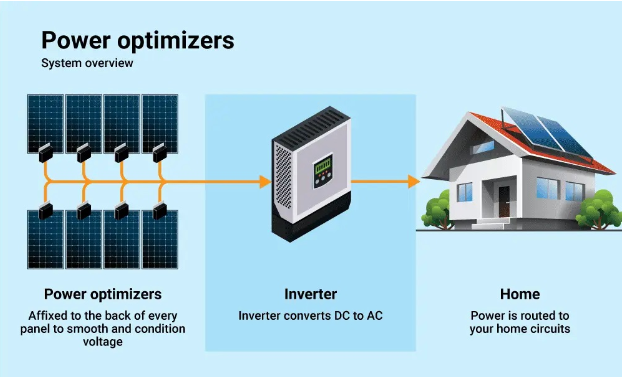
Due to their versatility, Power optimisers have gained popularity in commercial solar panel system installations. They meet Fire Safety Regulations and British Standards BS7671 electrical requirements without the need for additional equipment. Power optimisers are particularly well-suited for complex system designs and effectively mitigate shading issues, as they manage shading on a per-module or dual-module basis. This contrasts with String inverters, which are more affected by shading across the entire system. The adaptability of power optimisers makes them an efficient option for boosting energy production.
It provides additional safety protection through its DC rapid shut-down system, where each optimiser is decreased to 1 Volt DC. Power optimisers have a 25-year warranty, whereas the Inverters have 12 years plus can benefit from an additional 8 years, if purchased at the installation stage.
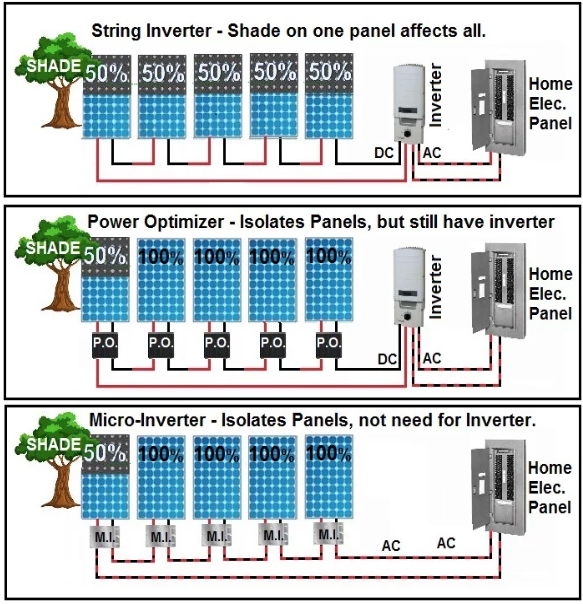
Differences between Micro-inverters and power optimisers
The main difference between Micro-inverters and Power optimisers is that Micro-inverters convert DC to AC directly underneath each solar panel. In contrast, Power optimisers send DC power to a central inverter for conversion to AC.
However, if an issue arises with a Power optimiser, it can be challenging to repair since roof access is required. Online monitoring helps identify the location of the defective optimizer, but an engineer must still physically access the roof to replace it, making repairs more costly compared to string inverters.
Micro-inverters’ advantage is that if one fails, the rest of the system can continue operating, ensuring ongoing energy production for your commercial premises.
Furthermore, exponentially more equipment is used in a Power Optimiser system than a String inverter system. This means there are more potential failure points and possibly higher maintenance costs, although the system is guaranteed for 25 years, so the manufacturer would cover the costs.
Power Optimisers Pros and Cons
Pros
- ✅ Easy system expansion.
- ✅ Module level power electronics (MLPE).
- ✅ Exceptional level of information on the online monitoring portal.
- ✅ Individual panel performance doesn’t impact other panels.
- ✅ 25-year warranty & lifespan on Optimisers.
- ✅ Make it easier to add panels to an existing system.
- ✅ Rapid Shut down system.
- ✅ Temperature sensing on Power optimisers.
- ✅ Optimal generation performance.
- ✅ Easier to obtain Insurance for the premises.
Cons
- ❌ More expensive to initial install.
- ❌ More points of failure.
- ❌ Possibly dearer to maintain.
Micro Inverters commercial solar system functionality
Micro-inverters perform the same basic function as Power Optimisers, except with Micro-Inverters, the DC to AC conversion is completed right at the back of the panel. Some Micro-inverter models allow you to attach two or four panels to each unit, making it cheaper and easier to install.
While standard String inverters will cap the electricity production of each panel by the lowest-producing panel in a string, Micro-inverters don’t have this issue as they function in a parallel circuit.
A Micro-inverter fully exploits the generation of each individual panel. Each solar panel and Micro-inverter combination can “do their best” and contribute as much power as possible. Micro-inverters work best for complex solar installations on multiple roof faces.
Micro-inverters have become quite a popular choice for commercial solar panel system installations. They don’t require additional equipment to meet Fire safety regulations and British standards BS7671 electricity regulation requirements, can be used for intricate system designs, and don’t have the same shading issues as String inverters.
Since Micro-inverters output AC power directly from each solar panel, they make it easier to expand or add more solar modules to an existing commercial solar panel system. Also, Micro-inverters typically have a 25-year lifespan, eliminating the need for replacement every 10 years, as with other inverter types.
However, if a Micro-inverter develops an issue, repairing it can be challenging because roof access is required. Online monitoring can help pinpoint the location of the faulty micro-inverter, but an engineer will still need to climb up, locate, and repair or replace it, which can be more costly than string inverters.
The advantage is that if an issue with one Micro-inverter, the rest of the system can keep operating and powering your business with energy.
Micro-Inverters Pro and cons
A Micro-inverter system requires significantly more equipment than a String inverter system, which increases the number of potential points of failure and could lead to higher maintenance costs. However, since most Micro-inverter systems come with a 25-year warranty, the manufacturer would generally cover any repair or replacement costs, mitigating the financial impact of this.
Micro-inverter Pros & Cons.
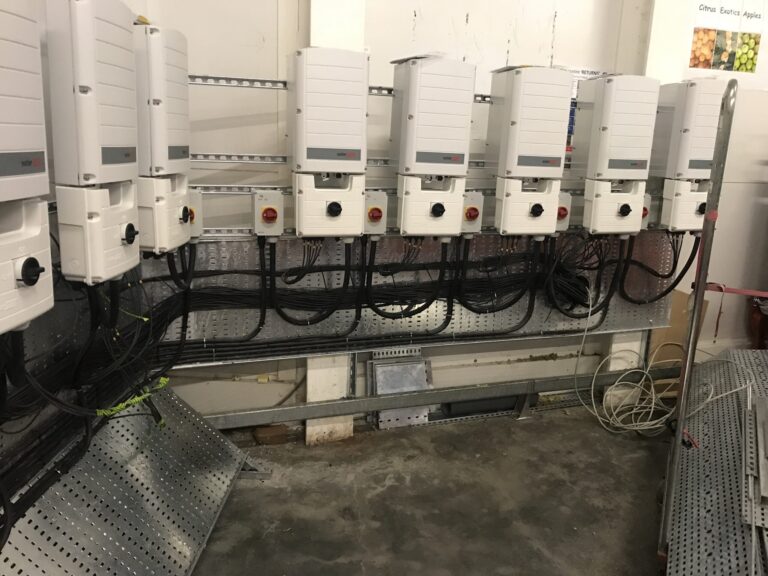
Pros
- ✅ Easy system expansion
- ✅ Module level power electronic (MLPE)
- ✅ Exceptional level of information on the online monitoring portal.
- ✅ Individual panel performance doesn’t impact other panels
- ✅ 25-year warranty & lifespan on Microinverters
- ✅ Make it easier to add panels to an existing system
- ✅ Optimal generation performance.
- ✅ Easier to obtain Insurance for the premises.
Cons
- ❌ More expensive to initial install
- ❌ More points of failure.
- ❌ Possibly dearer to maintain.
Speak To Our Experts
Once you have decided to invest in a commercial solar panel system, we recommend contacting our experts.
At Excel Energy, we deliver customised commercial solar panel system solutions designed to meet the unique energy needs of businesses across all industries. We recognise that each sector has different energy requirements, so we offer various solar inverter options, utilising the latest technologies from leading brands to ensure optimal performance and efficiency.
Our accredited experts can advise you on choosing the right solar panels and inverters for your business.
Contact our specialists today by calling 020 3834 9440 or completing our contact form.
